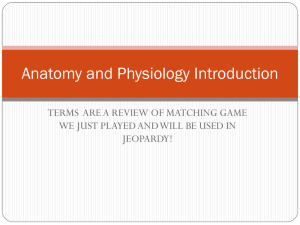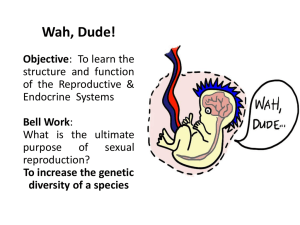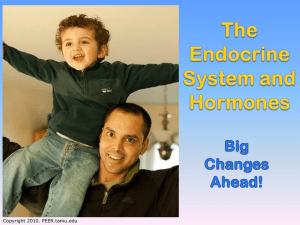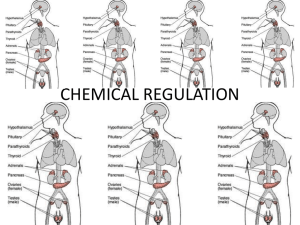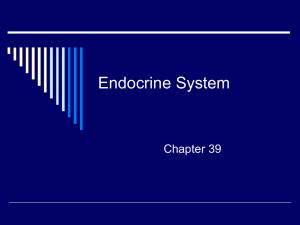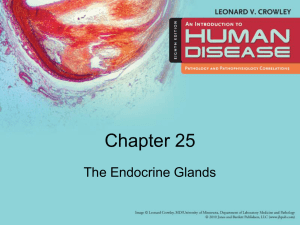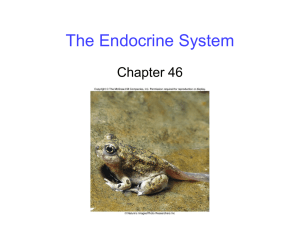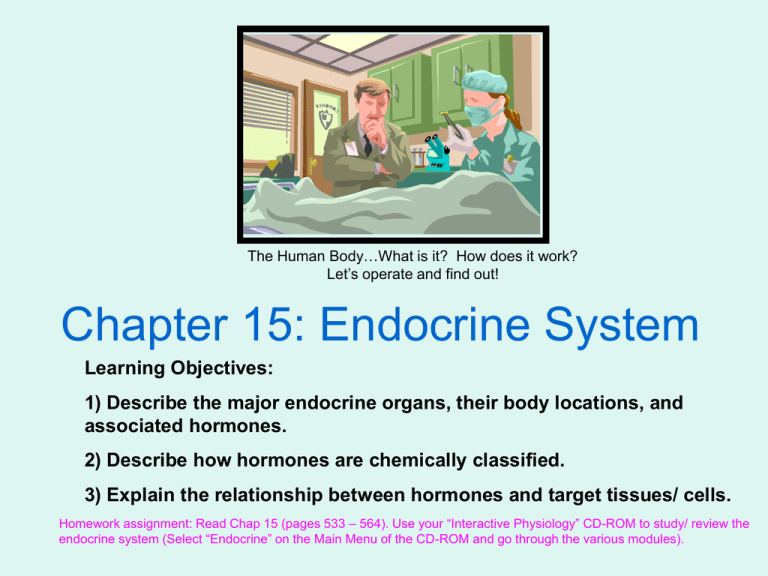
The Human Body…What is it? How does it work?
Let’s operate and find out!
Chapter 15: Endocrine System
Learning Objectives:
1) Describe the major endocrine organs, their body locations, and
associated hormones.
2) Describe how hormones are chemically classified.
3) Explain the relationship between hormones and target tissues/ cells.
Homework assignment: Read Chap 15 (pages 533 – 564). Use your “Interactive Physiology” CD-ROM to study/ review the
endocrine system (Select “Endocrine” on the Main Menu of the CD-ROM and go through the various modules).
PREDICT
• What’s does the “endocrine system” refer
to? What do you think?
BRAINSTORMING
• Activity to be presented in class
Major Endocrine Organs, page 533
PARTNER ACTIVITY: WHAT DO THE ENDOCRINE ORGANS DO?
Instructions: Using your textbook or other resource, match the endocrine organ with its
general description. Estimated Time: 8-10 minutes
1. pineal gland
a. Sits near base of the brain; secretes hormones regulating homeostasis; it is
functionally connected to the hypothalamus.
2. adrenal glands
b. An organ in the digestive and endocrine systems of vertebrates; produces
insulin, and glucagon.
3. pituitary gland
c. controlled by the hypothalamus and pituitary; produces thyroxine (T4) and
triiodothyronine (T3) which regulate the rate of metabolism and affect the
growth and rate of function of many other systems
4. thymus gland
d. links the nervous system to the endocrine system via the pituitary gland ;
controls body temperature, hunger, thirst
5. pancreas
e. sit on top of the kidneys; chiefly responsible for regulating the stress
response through the synthesis of cortisol and adrenaline.
6. hypothalamus
f. maintains the body's calcium level so that the nervous and muscular systems
can function properly; located in neck
7. Thyroid gland
g. located in the upper portion of the chest cavity just behind the sternum;
stimulates the production of certain infection-fighting cells.
8. Parathyroid glands
h. small endocrine gland in the brain; produces a hormone that may modulate
wake/sleep patterns called melatonin
A Closer Look at Hormones
• Hormones – _________ __________ released into the
blood to be transported throughout the body
• They are chemically classified as either amino acid based
or __________
• __________ bind to cellular receptors and initiate a
response within a matter of time (seconds, minutes, hours
or days)
Hormones influence the activity
of only certain tissue cells
referred to as target cells – act
like two puzzle pieces made for
each other. Hormones affect
target cells by altering cell activity
– either increase or decrease
normal cellular processes. Target
cells have special receptor areas.
Hormones Continued
• Hormones produce one or more of the following
cellular changes in _______ cells:
–
–
–
–
–
Alter ________ membrane permeability
Stimulate ________ synthesis
Activate or deactivate _______ systems
Induce secretory activity
Stimulate _______
Animation – target cells. In order for a target cell to
respond to a hormone, the cell must have specific
protein receptors on its plasma membrane or interior to
which that hormone can bind.
A Closer Look at the Endocrine Organs
Pituitary gland or ___________ – two-lobed organ that secretes at least eight major
hormones. Pituitary gland hormonally influences many body organs including the
thyroid, adrenal glands, reproductive system, kidneys, and ___________
Basic anatomy:
_______________ (with
hypothalamic-hypophyseal
nerve bundle)
_________________ – posterior lobe
(neural tissue) and the infundibulum;
receives, stores, and releases hormones
from the hypothalamus
__________________ – anterior lobe,
made up of glandular tissue; synthesizes
and secretes a number of hormones
Hormones dumped into
bloodstream ______ or ________
Pituitary continued
Posterior lobe hormones:
- _____________
- Antidiuretic Hormone (___) or ___________
Anterior lobe hormones:
Tropins –
- Thyroid-stimulating Hormone (___)
hormones
that
- Adrenocorticotropic Hormone (_____) regulate
the
secretory
- Follicle-stimulating Hormone (___)
action of
other
endocrine
- Luteinizing Hormone (___)
glands
- Growth Hormone (___)
- Prolactin (___)
What do these hormones do?
Instructions: Working individually, take a few minutes to investigate more about each of
the hormones. For each hormone, answer the question, “What does this hormone do?”
Write this information in your notes. Estimated time: 7-8 minutes.
1.Oxytocin (pg 545)
2. ADH (pg 545)
3. TSH (pg 544)
4. ACTH (pg 544)
5. FSH (pg 544)
6. LH (pg 544)
7. GH (pg 542)
8. PRL (pg 544)
Small Group Activity – Pituitary Initiated Disorders
Estimated Time: 10 minutes
• Form a small group of 4 people.
• Obtain a “Pituitary Disorders” packet.
• Put yourself in the role of a medical investigator.
Each card in the packet represents a
disease/symptoms. Can you name the diseases/
syndromes?
• You may use your textbook as a resource (NOTE:
Table 15.1 Pituitary Hormones pages 546 – 547 may be
helpful)
Endocrine Organs Continued
Thyroid Gland – anterior neck; on the _____; just inferior to the _______.
Two lobes connected by _______. Composed of spherical follicles
containing _______. The walls of the follicles are made up of squamous
epithelial cells which produce a glycoprotein called thyroglobulin.
Parafollicular cells produce calcitonin.
Remember that TSH from pituitary acts on the thyroid.
Practice, page 548
Instructions: Practice labeling & learning the anatomy of the thyroid on the handout sheet.
Thyroid continued
The Thyroid secretes:
• Thyroid Hormone (____) which is actually two iodinecontaining amine hormones, thyroxine (T4) and
triiodothyronine (T3).
• T4 – is secreted from the thyroid __________
• TH affects virtually every cell in the body except for the
adult _____, ________, _______, _______, and the
thyroid gland itself.
• Calcitonin – a hormone that regulates blood ________
levels (secreted from the parafollicular cells)
Take a moment to review the effects of T3 and T4 in
Table 15.2, page 549.
Thyroid Disorders
• _____thyrodism or myxedema –
symptoms include low metabolic
rate, feeling cold, constipation,
mental sluggishness, possibly goiter
• ______thyroidism – too much TH;
causes elevated metabolic rate,
sweating, rapid irregular heartbeat, and
possibly protruding eyeballs (Graves
Disease)
Parathyroid glands, page 552
•Tiny glands
embedded in the
posterior aspect of
the thyroid
Side Note: How
many parathyroid
glands can you see
in this picture?
Parathyroid continued
•
Secrete
parathormone
(PTH) which
regulates calcium
balance in the
blood via bone,
intestines, and
kidneys
•
Calcium key for
transmission of
______ _______,
muscle ________,
and blood ______.
Parathyroid Gland Disorders
• Hyperparathyroidism – rare (usually the
result of a tumor); calcium is ________
______ ___ ______. Calcium deposits
may also form in soft tissues throughout
the body.
• Hypoparathyroidism – loss of ________,
muscle ______, and _________.
Untreated symptoms lead to respiratory
paralysis and death.
Adrenal Glands, page 554
(also known as the Suprarenal Glands)
• Pyramid-shaped organs sitting atop the kidneys
• Produces well over 2 dozen steroid hormones collectively known
as _____________________
mineralocorticoids
glucocorticoids
gonadocorticoids
epinephrine
Adrenal Gland Hormones, pg 555
1) ___________corticoids (chiefly __________ which
maintains Na+ balance by reducing excretion of
sodium from the body and stimulates reabsorption of
Na+ by the kidneys; affects blood pressure)
2) _________corticoids(chiefly _________ which
helps the body resist stress by keeping blood sugar
levels relatively constant and maintaining blood
volume and preventing water shift into tissue)
Cortisol provokes:
– Formation of glucose from noncarbohydrates
– Rises in blood _______, fatty acids, and amino acids
Adrenocortical Hormones continued
3) ________corticoids (chiefly _________. Most
gonadocorticoids secreted are androgens (male sex
hormones); Most important one is testosterone.
Androgens contribute to:
– The onset of ________
– The appearance of secondary ____ characteristics
– Sex drive
4) ____________ (more potent stimulator of the heart and
metabolic activities) and ___________ (more influential
on peripheral vasoconstriction and blood pressure)
Secretion of these hormones causes:
– Blood glucose levels to ____
– Blood vessels to _______
– The heart to beat ________
– Blood to be diverted to the brain, heart, and skeletal
muscle
Adrenal Disorders
• ________ syndrome – glucocorticoid
excess (may be caused by an ACTHreleasing pituitary tumor)
• _________ disease – deficits in both
glococoticoids and mineralocorticoids;
victims loose weight, glucose and Na+
levels drop while K+ rise resulting in
severe dehydration
Pancreas, page 560
• A triangular gland, which has both _______
and _______ cells, located behind the
stomach
•______ cells produce an
enzyme-rich juice used for
digestion (exocrine product)
Pancreatic islets (islets of
Langerhans) produce
hormones (endocrine
products). The islets contain
two major cell types:
Alpha () cells that produce
glucagon (hyperglycemic
agent)
Beta () cells that produce
insulin (hypoglycemic
agent)
Glucagon
One molecule of this hormone can cause the release of 100 million
glucose molecules into the blood!
• A 29-amino-acid polypeptide hormone that
is a potent _______glycemic agent
• Its major target is the _____, where it
promotes:
– The breakdown of glycogen to ______
– Synthesis of glucose from ______ acid and
noncarbohydrates
– Release of glucose to the blood from liver cells
Insulin
• A ___-amino-acid protein consisting of two
amino acid chains linked by disulfide
bonds
• Insulin:
– _______ blood glucose levels
– Enhances transport of glucose into ____ cells
– Counters metabolic activity that would
enhance blood glucose levels
– Also influences _____ and ___ metabolism
Blood Glucose Regulation
•The hyperglycemic
effects of glucagon
and the
hypoglycemic
effects of insulin
Side Note:
Glucagon and
insulin do opposite
tasks; the counteroppose one
another
Pancreas Disorders
_________ Mellitus (DM)
• Results from hyposecretion or hypoactivity
of _________
• The three cardinal signs of DM are:
– Polyuria –
– Polydipsia –
– Polyphagia –
Hyperinsulinism – excessive insulin secretion,
resulting in hypoglycemia
Pineal Gland, page 563
• Small gland hanging from the ______ of
the third ventricle of the brain
• Secretory product is __________
• Melatonin is involved with:
– Day/night cycles
– Physiological processes that show rhythmic
variations (body ________, ______, and
appetite)
Thymus Gland, page
564
• Lobulated gland located deep to the
________ in the thorax
• Major hormonal products are
thymopoietins and thymosins
• These hormones are essential for the
development of the __ __________ (T
cells) of the immune system
Chapter Review
As a result of the preceding information you should now be equipped to answer the following
questions.
1. The pituitary gland is connected to the hypothalamus of the brain via a
narrow connected stalk-like area called the _____________?
2.The anterior of the pituitary is also known as the _________?
3. The posterior of the pituitary secretes the hormones __________ and
____________?
4. What does ADH control?
5. GH deficiency in children results in slowed bone growth and a condition
known as _____________?
Chapter Review continued
6. What is the median tissue mass that that connects the
two lobes of the thyroid?
7. What two iodine-containing amine hormones actually
make up TH?
8. Severe hypothryoidism in infants results in mental
retardation, short/ disporportionate body size, and a thick
tongue/neck. This condition is known as ___________?
9. A hyperthyroid condition resulting in bulging eyes,
elevated heartbeat, nervousness, and unexplained
weight loss?
Chapter Review continued
10. The beta cells of the pancreas produce what
hormone?
11. What does the hormone aldoesterone do?
12. What is PTH and what does it influence?






